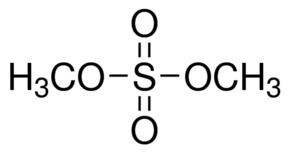Boiling point 188 °C Molar mass 126.13 g/mol | Density 1.33 g/cm³ Formula C2H6O4S Melting point -32 °C | |
 | ||
Related compounds | ||
Dimethyl sulfate market growth share size analysis and industry forecasts to 2020
Dimethyl sulfate is a chemical compound with formula (CH3O)2SO2. As the diester of methanol and sulfuric acid, its formula is often written as (CH3)2SO4 or even Me2SO4, where CH3 or Me is methyl. Me2SO4 is mainly used as a methylating agent in organic synthesis.
Contents
- Dimethyl sulfate market growth share size analysis and industry forecasts to 2020
- History
- Production
- Uses
- Methylation at oxygen
- Methylation at amine nitrogen
- Methylation at sulfur
- Other uses
- Alternatives
- Safety
- References
Under standard conditions, Me2SO4 is a colourless oily liquid with a slight onion-like odour (although smelling it would represent significant exposure). Like all strong alkylating agents, Me2SO4 is extremely toxic. Its use as a laboratory reagent has been superseded to some extent by methyl triflate, CF3SO3CH3, the methyl ester of trifluoromethanesulfonic acid.
History
Dimethyl sulfate was first discovered in the early 19th century in an impure form. P Claesson later extensively studied its preparation. It was used in chemical warfare in WW I.
Production
Dimethyl sulfate can be synthesized in the laboratory by many different syntheses, the simplest being the esterification of sulfuric acid with methanol:
Another possible synthesis involves distillation of methyl hydrogen sulfate:
Methyl nitrite and methyl chlorosulfonate also result in dimethyl sulfate:
Me2SO4 has been produced commercially since the 1920s. A common process is the continuous reaction of dimethyl ether with sulfur trioxide.
Uses
Dimethyl sulfate is best known as a reagent for the methylation of phenols, amines, and thiols. Typically, one methyl group is transferred more quickly than the second. Methyl transfer is typically assumed to occur via an SN2 reaction. Compared to other methylating agents, dimethyl sulfate is preferred by the industry because of its low cost and high reactivity.
Methylation at oxygen
Most commonly, Me2SO4 is employed to methylate phenols. Some simple alcohols are also suitably methylated, as illustrated by the conversion of tert-butanol to t-butyl methyl ether:
Alkoxide salts are rapidly methylated:
The methylation of sugars is called Haworth methylation
Methylation at amine nitrogen
Me2SO4 is used to prepare both quaternary ammonium salts or tertiary amines:
Quaternized fatty ammonium compounds are used as a surfactant or fabric softeners. Methylation to create a tertiary amine is illustrated as:
Methylation at sulfur
Similar to the methylation of alcohols, mercaptide salts are easily methylated by Me2SO4:
An example is:
This method has been used to prepare thioesters:
Other uses
Dimethyl sulfate can affect the base-specific cleavage of guanine in DNA by rupturing the imidazole rings present in guanine. This process can be used to determine base sequencing, cleavage on the DNA chain, and other applications.
Dimethyl sulfate also methylates adenine in single-stranded portions of DNA (e.g., those with proteins like RNA polymerase progressively melting and re-annealing the DNA). Upon re-annealing, these methyl groups interfere with adenine-guanine base-pairing. Nuclease S1 can then be used to cut the DNA in single-stranded regions (anywhere with a methylated adenine). This is an important technique for analyzing protein-DNA interactions.
Alternatives
Although dimethyl sulfate is highly effective and affordable, its toxicity has encouraged the use of other methylating reagents. Methyl iodide is a reagent used for O-methylation, like dimethyl sulfate, but is less hazardous and more expensive. Dimethyl carbonate, which is less reactive, has far lower toxicity compared to both dimethyl sulfate and methyl iodide and can be used instead of dimethyl sulfate for N-methylation. High pressure can be used to accelerate methylation by dimethyl carbonate. In general, the toxicity of methylating agents is correlated with their efficiency as methyl transfer reagents.
Safety
Dimethyl sulfate is carcinogenic and mutagenic, highly poisonous, corrosive, environmentally hazardous and volatile (presenting an inhalation hazard). It is considered a potential chemical weapon. Dimethyl sulfate is absorbed through the skin, mucous membranes, and gastrointestinal tract, and can cause a fatal delayed respiratory tract reaction. An ocular reaction is also common. There is no strong odor or immediate irritation to warn of lethal concentration in the air. The LD50 (acute, oral) is 205 mg/kg (rat) and 140 mg/kg (mouse), and LC50 (acute) is 45 ppm / 4 hours (rat). The vapor pressure of 65 Pa is sufficiently large to produce a lethal concentration in air by evaporation at 20 °C. Delayed toxicity allows potentially fatal exposures to occur prior to development of any warning symptoms. Symptoms may be delayed 6–24 hours. Concentrated solutions of bases (ammonia, alkalis) can be used to hydrolyze minor spills and residues on contaminated equipment, but the reaction may become violent with larger amounts of dimethyl sulfate (see ICSC). Although the compound hydrolyses in water, plain water cannot be assumed to hydrolyze dimethyl sulfate quickly enough for decontamination purposes. The hydrolysis product, monomethyl sulfate, is environmentally hazardous. In water, the compound is ultimately hydrolysed to sulfuric acid and methanol.
